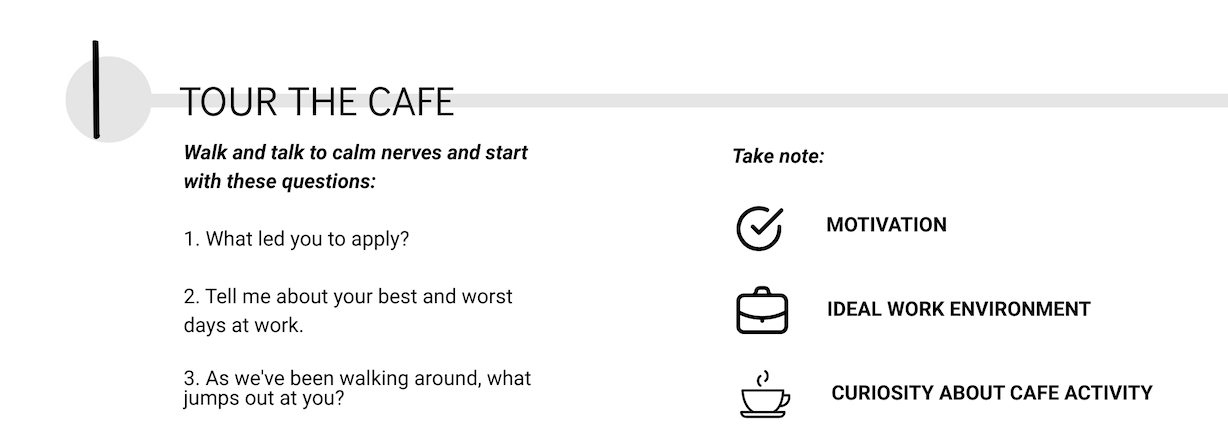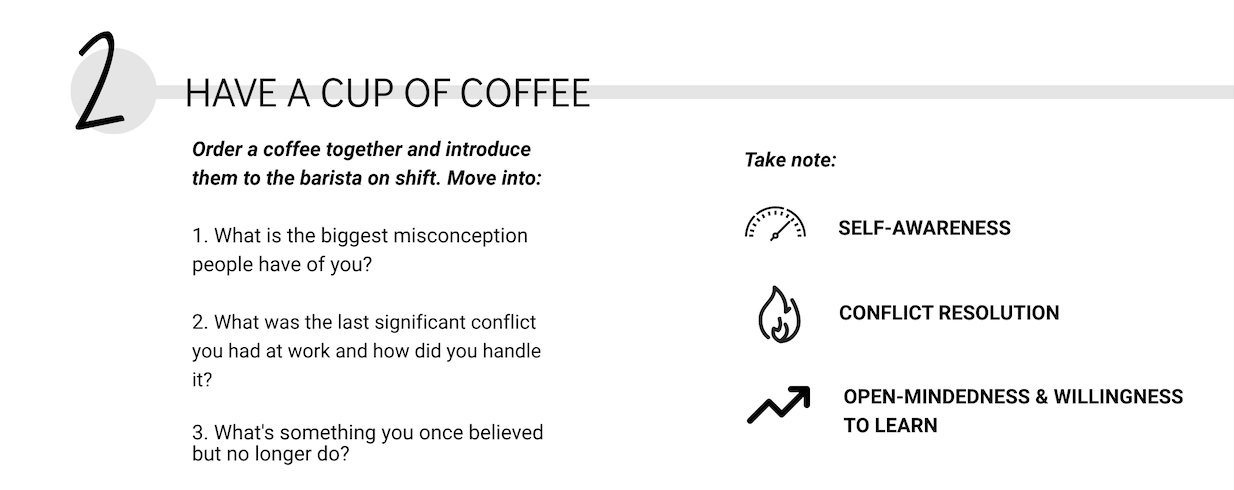Standard Operating Procedure: Strategic Interview Checklist
Of my own accord, I independently created these project pieces to test my professional skills and expand my knowledge and experience. I was not hired or paid to complete this work.
In succession of a targeted talent acquisition campaign I created for Temple Coffee Roasters, I designed an interviewing procedure to accompany the recruitment portion of my team-building project.
The intent of this checklist is to provide hiring managers with a guide to systematically recognize the makings of a solid hire.
With carefully selected questions, this interview process works to guide the interviewer to quickly deduce the probability of their success as a team member of Temple Coffee Roasters.
HEADER
At the top of the process, we have Temple Coffee’s logo for brand consistency and three main points that the interview ought to address:
Is this candidate a good “ability fit”? Will they be able to do the job?
Are they a good “culture fit”? Are the values they exude aligned with that of the company’s?
Is Temple Coffee Roasters a good “lifestyle fit” for the candidate? Is the company in line with their career goals, their ideal work environment and culture?
Keeping these three core points at the top of the process is intended to help the interviewer focus on the goal of the interview: to address these three points.
PART 1: TOUR THE CAFE
The first step of the interview process is designed to be the icebreaker portion of the meeting.
Here, the interviewer is prompted to take the candidate on a tour of the cafe, opening up the possibility for the hiring manager to notice how the candidate interacts with both the staff met in passing and the guests encountered as they move about the establishment.
In addition, my goal in this step of the process is to give the interviewee the benefit of easing into the nerve-wracking experience of being interviewed. Walking side-by-side and engaging the questions outlined in this step will set the stage for a more relaxed and productive meeting.
On the left, there are selected questions for the interviewer to ask during this portion of the interview. In tandem on the right, are areas where these questions are designed to shed light on the probability that this candidate is a “culture fit.”
For example, the question: “Tell me about your best and worst days at work” will likely give insight into the work environments in which this interviewee thrives and which ones they struggle. This will undoubtedly help the hiring manager deduce if a cafe position falls into one of those two categories.
PART 2: HAVE A CUP OF COFFEE
Part 2 prompts the interviewer to take the candidate through the cafe line and order a drink with the barista. This, in itself, will be a telling situation to put an interviewee through.
This practice will reveal their knowledge of the menu, sociability in interacting with the barista and register operator, and finally, is also a secret test. The interviewer will introduce the interviewee to the barista on shift to later see if the candidate can recall the barista’s name. In the culture of coffee houses where regulars expect to be treated with familiarity, it’s vital that a new hire has the ability to meet someone new and quickly retain their name and drink order.
This touches on the “ability fit” of our three-layered goal in the interview process.
The questions provided are intentionally outlined to reveal key points of the prospect’s self-awareness, behavior in conflict, and their teachability.
PART 3: TURN THE TABLES
The final portion of the interview gives the interviewee the opportunity to voice anything they’d like to share or ask any questions they have. This space is intended to build on the knowledge the hiring manager has gained throughout the interview on the interviewee’s “ability, culture, and lifestyle fit.”
Hiring the wrong candidate takes a toll on company efficiency, team morale, and ultimately, the employee that wasn’t set up to succeed.
Wise team-building begins with targeted talent acquisition, and that acquisition must then be followed up with a guided interview process to aid hiring managers in making thoughtful additions to their team.
Here’s a quick overview of how I used Piktochart to create this SOP:





